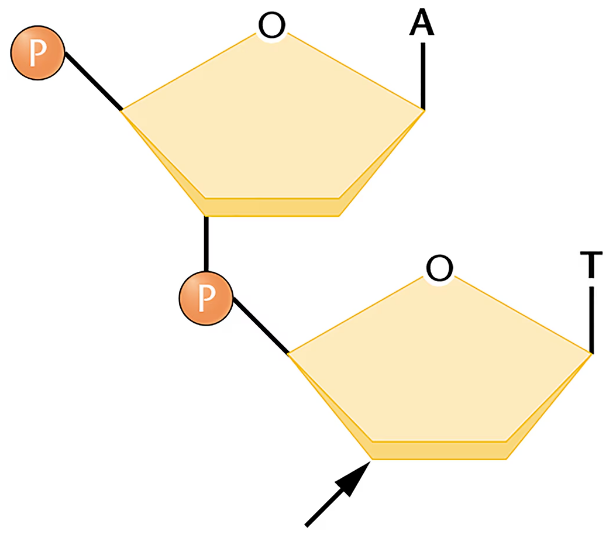What did the Watson–Crick model suggest about the replication of DNA?
Table of contents
- 1. Introduction to Genetics51m
- 2. Mendel's Laws of Inheritance3h 37m
- 3. Extensions to Mendelian Inheritance2h 41m
- 4. Genetic Mapping and Linkage2h 28m
- 5. Genetics of Bacteria and Viruses1h 21m
- 6. Chromosomal Variation1h 48m
- 7. DNA and Chromosome Structure56m
- 8. DNA Replication1h 10m
- 9. Mitosis and Meiosis1h 34m
- 10. Transcription1h 0m
- 11. Translation58m
- 12. Gene Regulation in Prokaryotes1h 19m
- 13. Gene Regulation in Eukaryotes44m
- 14. Genetic Control of Development44m
- 15. Genomes and Genomics1h 50m
- 16. Transposable Elements47m
- 17. Mutation, Repair, and Recombination1h 6m
- 18. Molecular Genetic Tools19m
- 19. Cancer Genetics29m
- 20. Quantitative Genetics1h 26m
- 21. Population Genetics50m
- 22. Evolutionary Genetics29m
7. DNA and Chromosome Structure
DNA Structure
Problem 30c
Textbook Question
Consider the drawing of a dinucleotide below.
Suppose that the molecule was cleaved with the enzyme spleen phosphodiesterase, which breaks the covalent bond connecting the phosphate to C-5'. After cleavage, to which nucleoside is the phosphate now attached (A or T)?

 Verified step by step guidance
Verified step by step guidance1
Understand the structure of a dinucleotide: A dinucleotide consists of two nucleotides connected by a phosphodiester bond. Each nucleotide is made up of a sugar (deoxyribose in DNA), a phosphate group, and a nitrogenous base (Adenine (A) or Thymine (T) in this case).
Identify the role of spleen phosphodiesterase: This enzyme specifically cleaves the phosphodiester bond between the phosphate group and the 5' carbon of the sugar in the nucleotide. This means the phosphate group will no longer be attached to the 5' carbon of one nucleotide.
Determine the result of cleavage: After the cleavage, the phosphate group will remain attached to the 3' carbon of the sugar in the adjacent nucleotide. This is because the phosphodiester bond connects the 5' carbon of one nucleotide to the 3' carbon of the next nucleotide.
Analyze the dinucleotide structure: In the given dinucleotide, identify which nucleotide (A or T) has its phosphate group originally attached to the 5' carbon. After cleavage, the phosphate will transfer to the 3' carbon of the adjacent nucleotide.
Conclude the attachment: Based on the cleavage mechanism, determine whether the phosphate group is now attached to the nucleoside containing Adenine (A) or Thymine (T). This depends on the orientation of the dinucleotide and the position of the cleavage.
 Verified video answer for a similar problem:
Verified video answer for a similar problem:This video solution was recommended by our tutors as helpful for the problem above
Video duration:
1mPlay a video:
Was this helpful?
Key Concepts
Here are the essential concepts you must grasp in order to answer the question correctly.
Nucleotides and Nucleosides
Nucleotides are the building blocks of nucleic acids, consisting of a phosphate group, a sugar (ribose or deoxyribose), and a nitrogenous base (adenine, thymine, cytosine, or guanine). Nucleosides are similar but lack the phosphate group, comprising only the sugar and the nitrogenous base. Understanding the difference between these two is crucial for analyzing the effects of enzymatic cleavage on nucleic acid structure.
Recommended video:
Guided course

DNA Structure
Phosphodiester Bonds
Phosphodiester bonds are covalent linkages that connect the phosphate group of one nucleotide to the hydroxyl group on the sugar of another nucleotide, forming the backbone of DNA and RNA. The cleavage of these bonds by enzymes like spleen phosphodiesterase alters the structure of nucleic acids, impacting their function and stability. Recognizing how these bonds are formed and broken is essential for understanding the question.
Recommended video:
Guided course

DNA Structure
Enzymatic Cleavage
Enzymatic cleavage refers to the process by which enzymes break specific chemical bonds in molecules. In this case, spleen phosphodiesterase cleaves the bond between the phosphate group and the C-5' carbon of the sugar in a nucleotide. This action determines the attachment of the phosphate group to either adenine (A) or thymine (T), which is critical for answering the question regarding the resulting nucleoside.
Recommended video:
Guided course

Post Translational Modifications
Related Videos
Related Practice
Textbook Question
1083
views


